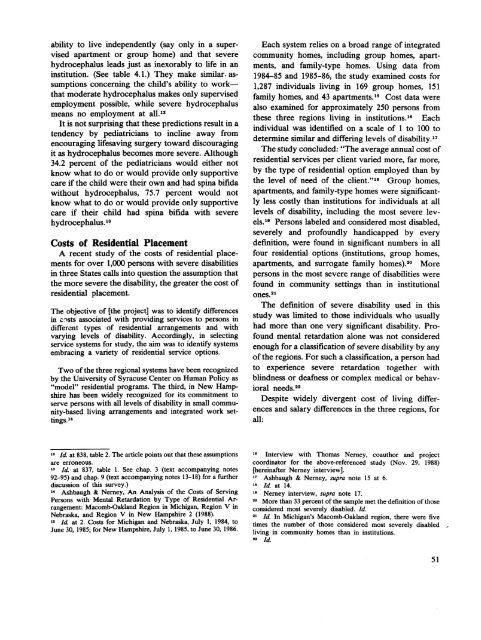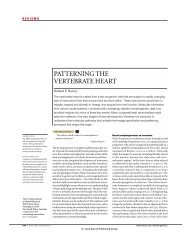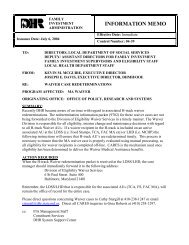PDF1 - University of Maryland School of Law
PDF1 - University of Maryland School of Law
PDF1 - University of Maryland School of Law
Create successful ePaper yourself
Turn your PDF publications into a flip-book with our unique Google optimized e-Paper software.
ability to live independently (say only in a supervisedapartment or group home) and that severehydrocephalus leads just as inexorably to life in aninstitution. (See table 4.1.) They make similar, assumptionsconcerning the child's ability to work—that moderate hydrocephalus makes only supervisedemployment possible, while severe hydrocephalusmeans no employment at all. 12It is not surprising that these predictions result in atendency by pediatricians to incline away fromencouraging lifesaving surgery toward discouragingit as hydrocephalus becomes more severe. Although34.2 percent <strong>of</strong> the pediatricians would either notknow what to do or would provide only supportivecare if the child were their own and had spina bifidawithout hydrocephalus, 75.7 percent would notknow what to do or would provide only supportivecare if their child had spina bifida with severehydrocephalus. 13Costs <strong>of</strong> Residential PlacementA recent study <strong>of</strong> the costs <strong>of</strong> residential placementsfor over 1,000 persons with severe disabilitiesin three States calls into question the assumption thatthe more severe the disability, the greater the cost <strong>of</strong>residential placement.The objective <strong>of</strong> [the project] was to identify differencesin cr>sts associated with providing services to persons indifferent types <strong>of</strong> residential arrangements and withvarying levels <strong>of</strong> disability. Accordingly, in selectingservice systems for study, the aim was to identify systemsembracing a variety <strong>of</strong> residential service options.Two <strong>of</strong> the three regional systems have been recognizedby the <strong>University</strong> <strong>of</strong> Syracuse Center on Human Policy as"model" residential programs. The third, in New Hampshirehas been widely recognized for its commitment toserve persons with all levels <strong>of</strong> disability in small community-basedliving arrangements and integrated work settings.14Each system relies on a broad range <strong>of</strong> integratedcommunity homes, including group homes, apartments,and family-type homes. Using data from1984-85 and 1985-86, the study examined costs for1,287 individuals living in 169 group homes, 151family homes, and 43 apartments. 15 Cost data werealso examined for approximately 250 persons fromthese three regions living in institutions. 16 Eachindividual was identified on a scale <strong>of</strong> 1 to 100 todetermine similar and differing levels <strong>of</strong> disability. 17The study concluded: "The average annual cost <strong>of</strong>residential services per client varied more, far more,by the type <strong>of</strong> residential option employed than bythe level <strong>of</strong> need <strong>of</strong> the client." 18 Group homes,apartments, and family-type homes were significantlyless costly than institutions for individuals at alllevels <strong>of</strong> disability, including the most severe levels.19 Persons labeled and considered most disabled,severely and pr<strong>of</strong>oundly handicapped by everydefinition, were found in significant numbers in allfour residential options (institutions, group homes,apartments, and surrogate family homes). 20 Morepersons in the most severe range <strong>of</strong> disabilities werefound in community settings than in institutionalones. 21The definition <strong>of</strong> severe disability used in thisstudy was limited to those individuals who usuallyhad more than one very significant disability. Pr<strong>of</strong>oundmental retardation alone was not consideredenough for a classification <strong>of</strong> severe disability by any<strong>of</strong> the regions. For such a classification, a person hadto experience severe retardation together withblindness or deafness or complex medical or behavioralneeds. 22Despite widely divergent cost <strong>of</strong> living differencesand salary differences in the three regions, forall:12Id. at 838, table 2. The article points out that these assumptionsare erroneous.13Id at 837, table 1. See chap. 3 (text accompanying notes92-95) and chap. 9 (text accompanying notes 13-18) for a furtherdiscussion <strong>of</strong> this survey.)14Ashbaugh & Nerney, An Analysis <strong>of</strong> the Costs <strong>of</strong> ServingPersons with Mental Retardation by Type <strong>of</strong> Residential Arrangement:Macomb-Oakland Region in Michigan, Region V inNebraska, and Region V in New Hampshire 2 (1988).15Id at 2. Costs for Michigan and Nebraska, July 1, 1984, toJune 30, 1985; for New Hampshire, July 1, 1985, to June 30, 1986.16Interview with Thomas Nerney, coauthor and projectcoordinator for the above-referenced study (Nov. 29, 1988)[hereinafter Nerney interview].17Ashbaugh & Nerney, supra note 15 at 6.18Id. at 14.19Nerney interview, supra note 17.20More than 33 percent <strong>of</strong> the sample met the definition <strong>of</strong> thoseconsidered most severely disabled. Id.21Id. In Michigan's Macomb-Oakland region, there were fivetimes the number <strong>of</strong> those considered most severely disabledliving in community homes than in institutions.22Id.51
















